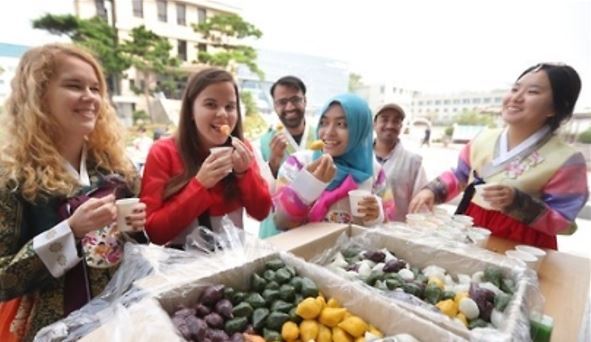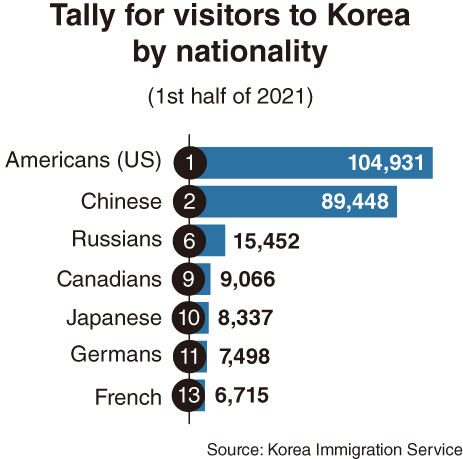[News Focus] US nationals become No. 1 in tally for inbound visitors
By Kim Yon-sePublished : Aug. 15, 2021 - 18:31

SEJONG -- US nationals have become the largest group of foreign visitors to South Korea by nationality, though they placed No. 4 in the tally in 2018 and 2019 and No. 3 in 2020.
According to the Korea Immigration Service, the number of inbound travelers from the US reached 104,931 during the first half of 2021.
US nationals overtook Chinese (formerly No. 1), Japanese and Taiwanese in the tally, while the situation is estimated to be affected by the pandemic. The number of inbound travelers from China, Japan and Taiwan marked 89,448, 8,337 and 2,690, respectively, in the same January-June period.
Data from the KIS showed that the number of US nationals declined sharply in the first quarter of 2020, when the number of COVID-19 infections grew rapidly in Korea.
But the number of visitors to Korea from the US has gradually increased after the virus dealt a severe blow to North America starting in the second quarter of 2020.

For Chinese nationals, an increase of inbound travelers from China was seen when the novel coronavirus initially hit Wuhan in late 2019 and early 2020. But they started to stay at home after the number of infections in Korea grew faster than in China, starting from March 2020.
A similar trend, in which US nationals outstrip Chinese in inbound visitors, continued to be seen this year.
Over the first half of this year, placing No. 3 on the list were visitors from the Philippines at 52,819 following the US and China. Among the next on the list were those from Myanmar (28,097), Indonesia (22,843), Russia (15,452), India (14,488), Vietnam (11,309) and Canada (9,066).
Japanese -- No. 2 in 2017, 2018 and 2019 -- ranked 10th in the first half of 2021’s tally with 8,337, while Taiwan’s ranking slid from No. 3 to No. 16.
Among noteworthy declines, the number of travelers from Macao plunged by 99.8 percent on-year -- from 5,884 in the first half of 2020 to 14 in the first half of 2021. Hong Kong posted a 99.4 percent decline from 86,466 to 533, and Singapore posted a 96.6 percent decline from 17,119 to 574.
Meanwhile, the number of foreigners staying in Korea -- both as long-term and short-term residents -- has dropped to its lowest level, 1.98 million, in more than four years amid the pandemic.
According to the KIS, the tally of foreign nationals in the nation was 2.52 million in December 2019, 2.37 million in December 2018, 2.18 million in December 2017 and 2.05 million in December 2016.
The June 2021 figure marked a 21.5 percent decrease in only 18 months, meaning there were 540,000 fewer foreign nationals than the 2.52 million tallied at the end of 2019.
The drop was particularly notable among short-term visitors -- those with permission to stay in Korea for less than 91 days. The figure declined 46.3 percent over the corresponding 18 months to post 413,705 as of June 2021.
Over the December 2019-June 2021 period, the number of long-term visitors -- people staying 91 days or longer – fell by 9.4 percent, from 1.73 million to 1.56 million.
The average age of foreigners in Korea remained under 40, while the average age of South Koreans had reached 43.4 as of June 2021.
Expatriates staying in the nation in their 30s were the most numerous at 27.7 percent (547,974) of the 1.98 million total for both short- and long-term stays.
Those in their 20s made up 21.3 percent (422,340) of the total, followed by those in their 40s at 16.8 percent and those in their 50s at 15.3 percent. Those aged 60 or over and those under 20 took up 12.4 percent and 6.5 percent, respectively.
















![[KH Explains] Hyundai's full hybrid edge to pay off amid slow transition to pure EVs](http://res.heraldm.com/phpwas/restmb_idxmake.php?idx=652&simg=/content/image/2024/04/18/20240418050645_0.jpg&u=20240418181020)

![[Today’s K-pop] Zico drops snippet of collaboration with Jennie](http://res.heraldm.com/phpwas/restmb_idxmake.php?idx=642&simg=/content/image/2024/04/18/20240418050702_0.jpg&u=)